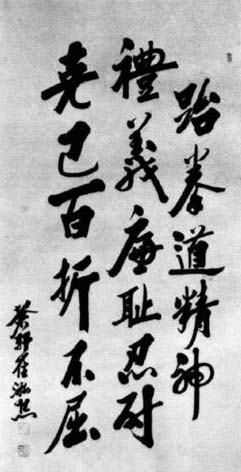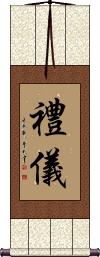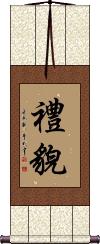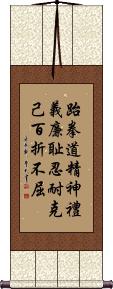Many custom options...
And formats...

禮 in Chinese / Japanese...
Buy an 禮 calligraphy wall scroll here!
Personalize your custom “禮” project by clicking the button next to your favorite “禮” title below...
Respect
Politeness, Gratitude and Propriety
礼 is one of the five tenets of Confucius.
Beyond respect, 礼 can also be translated as propriety, good manners, politeness, rite, worship, or an expression of gratitude.
We show respect by speaking and acting with courtesy. We treat others with dignity and honor the rules of our family, school, and nation. Respect yourself, and others will respect you.
 Please note that Japanese use this simplified 礼 version of the original 禮 character for respect. 礼 also happens to be the same simplification used in mainland China. While 禮 is the traditional and original version, 礼 has been used as a shorthand version for many centuries. Click on the big 禮 character to the right if you want the Traditional Chinese and older Japanese versions.
Please note that Japanese use this simplified 礼 version of the original 禮 character for respect. 礼 also happens to be the same simplification used in mainland China. While 禮 is the traditional and original version, 礼 has been used as a shorthand version for many centuries. Click on the big 禮 character to the right if you want the Traditional Chinese and older Japanese versions.
This is also a virtue of the Samurai Warrior
See our page with just Code of the Samurai / Bushido here
Courtesy / Etiquette
In Chinese, old Korean Hanja, and old Japanese Kanji, 禮儀 means “etiquette” or “courtesy.”
You'll also find a Japanese entry on our website, which uses a modern/simplified first Kanji. The characters shown here compose the best choice if your audience is Chinese or Korean - but also acceptable if you want an ancient-style Japanese scroll (in modern Japanese, it has the same pronunciation, but is written 礼儀).
Note: This can also be translated as propriety, decorum, or formality.
Courtesy / Politeness
禮貌 is a Chinese and old Korean word that means courtesy or politeness.
Courtesy is being polite and having good manners. When you speak and act courteously, you give others a feeling of being valued and respected. Greet people pleasantly. Bring courtesy home. Your family needs it most of all. Courtesy helps life to go smoothly.
If you put the words "fēi cháng bù" in front of this, it is like adding "very much not." it’s a great insult in China, as nobody wants to be called "extremely discourteous" or "very much impolite."
Reza
Courtesy / Etiquette
In Japanese, 礼儀 means “manners,” “courtesy,” or “etiquette.”
This also clearly means etiquette in Chinese, though the first Japanese Kanji has been “modernized” and happens to be the same as the modern Simplified Chinese version. Therefore, this word will be understood by both Japanese and Chinese people but best if your audience is mostly Japanese (Chinese people would generally prefer the ancient Traditional Chinese version).
The Five Tenets of Confucius
The Five Cardinal Rules / Virtues of Confucius
仁義禮智信 are the core of Confucius's philosophy.
Simply stated:
仁 = Benevolence / Charity
義 = Justice / Rectitude
禮 = Courtesy / Politeness / Tact
智 = Wisdom / Knowledge
信 = Fidelity / Trust / Sincerity
Many of these concepts can be found in various religious teachings. It should be clearly understood that Confucianism is not a religion but should instead be considered a moral code for a proper and civilized society.
This title is also labeled “5 Confucian virtues.”
![]() If you order this from the Japanese calligrapher, expect the middle Kanji to be written in a more simple form (as seen to the right). This can also be romanized as "jin gi rei satoshi shin" in Japanese. Not all Japanese will recognize this as Confucian tenets but they will know all the meanings of the characters.
If you order this from the Japanese calligrapher, expect the middle Kanji to be written in a more simple form (as seen to the right). This can also be romanized as "jin gi rei satoshi shin" in Japanese. Not all Japanese will recognize this as Confucian tenets but they will know all the meanings of the characters.
Taekwondo Tenets / Spirit of Taekwon-do
跆拳道精神禮義廉耻忍耐克己百折不屈 is General Choi's writing that is often called “The Tenets of Taekwon-do.”

The actual title would be translated as “Taekwondo Spirit” or “The Spirit of Taekwondo.” It was originally written in Korean Hanja (Chinese characters used in Korea for about 1600 years).
General Choi's original calligraphy is shown to the right. Your custom calligraphy will be unique, and not an exact match, as each calligrapher has their own style.In modern times, the common form of written Korean is Hangul (a phonetic character set). The table below shows the text in Hangul and Hanja along with a pronunciation guide and a brief English translation:
| Traditional Korean Hanja | Modern Korean Hangul | Pronunciation | English |
| 跆拳道精神 | 태권도정신 | tae gweon do jeong sin | Taekwondo Spirit |
| 禮儀 | 예의 | ye yi | Courtesy / Etiquette / Propriety / Decorum / Formality |
| 廉耻 | 염치 | yeom ci | Integrity / Sense of Honor |
| 忍耐 | 인내 | in nae | Patience / Perseverance / Endurance |
| 克己 | 극기 | geug gi | Self-Control / Self-Denial / Self-Abnegation |
| 百折不屈 | 백절불굴 | baeg jeor bur gur | Indomitable Spirit (Undaunted even after repeated attacks from the opponent) |
| Note that the pronunciation is the official version now used in South Korea. However, it is different than what you may be used to. For instance, “Taekwon-do” is “tae gweon do.” This new romanization is supposed to be closer to actual Korean pronunciation. | |||
Not the results for 禮 that you were looking for?
Below are some entries from our dictionary that may match your 禮 search...
| Characters If shown, 2nd row is Simp. Chinese |
Pronunciation Romanization |
Simple Dictionary Definition |
禮 礼 see styles |
lǐ li3 li rai らい |
gift; rite; ceremony; CL:份[fen4]; propriety; etiquette; courtesy (personal name) Rai Worship, offerings, rites; ritual, ceremonial, decorum, courtesy, etiquette. |
禮儀 礼仪 see styles |
lǐ yí li3 yi2 li i |
More info & calligraphy: Courtesy / Etiquette |
禮貌 礼貌 see styles |
lǐ mào li3 mao4 li mao |
More info & calligraphy: Courtesy / Politeness |
三禮 三礼 see styles |
sān lǐ san1 li3 san li mire みれ |
(female given name) Mire Worship with 身, 口, 意, body, mouth, and mind. |
中禮 see styles |
nakarei / nakare なかれい |
(surname) Nakarei |
久禮 see styles |
kurei / kure くれい |
(surname) Kurei |
仁禮 see styles |
nirei / nire にれい |
(surname) Nirei |
伊禮 see styles |
irei / ire いれい |
(surname) Irei |
作禮 作礼 see styles |
zuò lǐ zuo4 li3 tso li sarai |
To pay one's respect by worship; to make an obeisance. |
保禮 see styles |
horei / hore ほれい |
(surname) Horei |
儀禮 仪礼 see styles |
yí lǐ yi2 li3 i li |
Rites and Ceremonies, part of the Confucian Classic of Rites 禮記|礼记[Li3 ji4] |
克禮 see styles |
katsunori かつのり |
(personal name) Katsunori |
免禮 免礼 see styles |
miǎn lǐ mian3 li3 mien li |
(formal) you may dispense with curtseying |
典禮 典礼 see styles |
diǎn lǐ dian3 li3 tien li |
ceremony; celebration See: 典礼 |
冠禮 冠礼 see styles |
guàn lǐ guan4 li3 kuan li |
the capping ceremony, a Confucian coming of age ceremony for males dating from pre-Qin times, performed when a boy reaches the age of 20, involving the ritual placing of caps on the head of the young man |
割禮 割礼 see styles |
gē lǐ ge1 li3 ko li |
circumcision (male or female) See: 割礼 |
勢禮 see styles |
serei / sere せれい |
(surname) Serei |
厚禮 厚礼 see styles |
hòu lǐ hou4 li3 hou li |
generous gifts See: 厚礼 |
受禮 受礼 see styles |
shòu lǐ shou4 li3 shou li |
to accept a gift; to acknowledge greetings |
周禮 周礼 see styles |
zhōu lǐ zhou1 li3 chou li |
the Rites of Zhou (in Confucianism) |
唱禮 唱礼 see styles |
chàng lǐ chang4 li3 ch`ang li chang li shōrai |
To announce the ceremonial duty. |
商禮 see styles |
hisaakira / hisakira ひさあきら |
(personal name) Hisaakira |
喪禮 丧礼 see styles |
sāng lǐ sang1 li3 sang li |
funeral |
囘禮 囘礼 see styles |
huí lǐ hui2 li3 hui li kai rei |
To return, or acknowledge a courtesy or gift. |
四禮 see styles |
shirei / shire しれい |
(surname) Shirei |
回禮 回礼 see styles |
huí lǐ hui2 li3 hui li |
to return a greeting; to send a gift in return See: 回礼 |
壽禮 寿礼 see styles |
shòu lǐ shou4 li3 shou li |
birthday present (for an old person) |
多禮 多礼 see styles |
duō lǐ duo1 li3 to li |
too polite; overcourteous See: 多礼 |
大禮 see styles |
oorei / oore おおれい |
(surname) Oorei |
失禮 失礼 see styles |
shī lǐ shi1 li3 shih li |
to act discourteously; forgive me (for my impropriety) See: 失礼 |
Click here for more 禮 results from our dictionary
The following table may be helpful for those studying Chinese or Japanese...
| Title | Characters | Romaji (Romanized Japanese) | Various forms of Romanized Chinese | |
| Respect | 禮 礼 | rei | lǐ / li3 / li | |
| Courtesy Etiquette | 禮儀 礼仪 | lǐ yì / li3 yi4 / li yi / liyi | li i / lii | |
| Courtesy Politeness | 禮貌 礼貌 | lǐ mào / li3 mao4 / li mao / limao | ||
| Reza | 禮薩 礼萨 | lǐ sà / li3 sa4 / li sa / lisa | ||
| Courtesy Etiquette | 礼儀 / 禮儀 礼仪 | rei gi / reigi | lǐ yì / li3 yi4 / li yi / liyi | li i / lii |
| The Five Tenets of Confucius | 仁義禮智信 仁义礼智信 | jin gi rei tomo nobu jingireitomonobu | rén yì lǐ zhì xìn ren2 yi4 li3 zhi4 xin4 ren yi li zhi xin renyilizhixin | jen i li chih hsin jenilichihhsin |
| Taekwondo Tenets Spirit of Taekwon-do | 跆拳道精神禮義廉耻忍耐克己百折不屈 跆拳道精神礼义廉耻忍耐克己百折不屈 | tái quán dào jīng shén lǐ yì lián chǐ rěn nài kè jǐ bǎi zhé bù qū tai2 quan2 dao4 jing1 shen2 li3 yi4 lian2 chi3 ren3 nai4 ke4 ji3 bai3 zhe2 bu4 qu1 tai quan dao jing shen li yi lian chi ren nai ke ji bai zhe bu qu | t`ai ch`üan tao ching shen li i lien ch`ih jen nai k`o chi pai che pu ch`ü tai chüan tao ching shen li i lien chih jen nai ko chi pai che pu chü |
|
| In some entries above you will see that characters have different versions above and below a line. In these cases, the characters above the line are Traditional Chinese, while the ones below are Simplified Chinese. | ||||
Successful Chinese Character and Japanese Kanji calligraphy searches within the last few hours...










